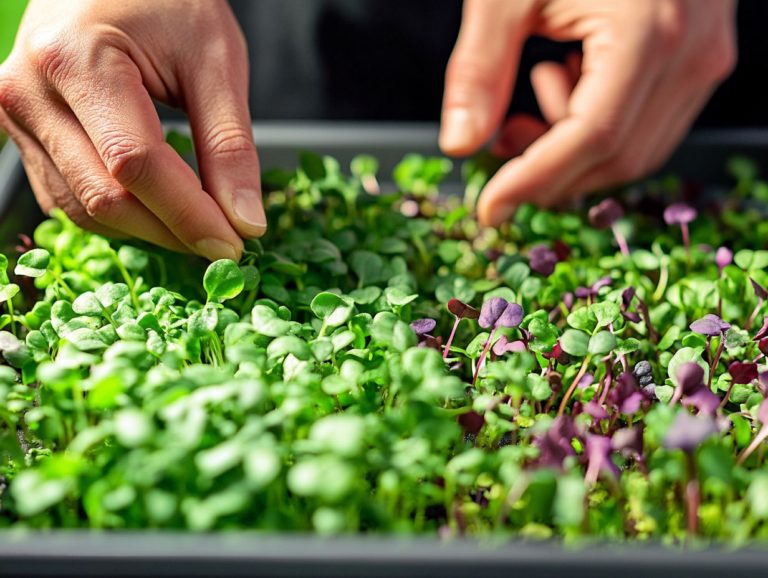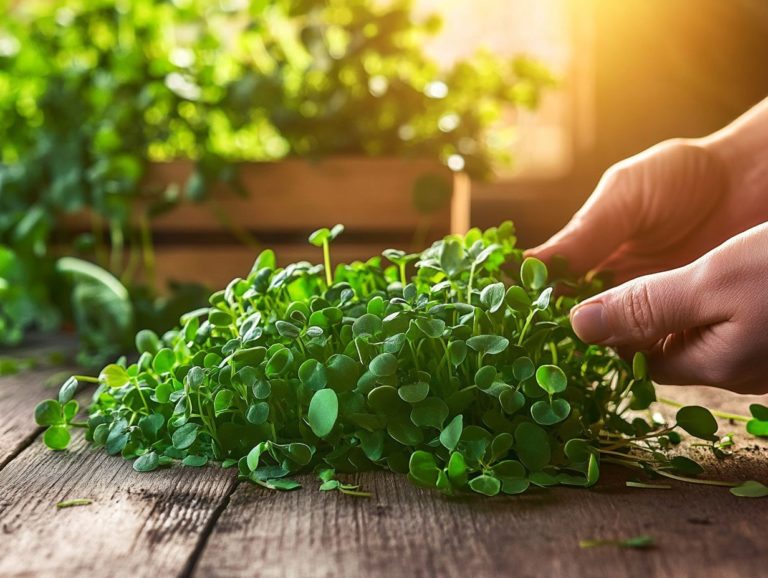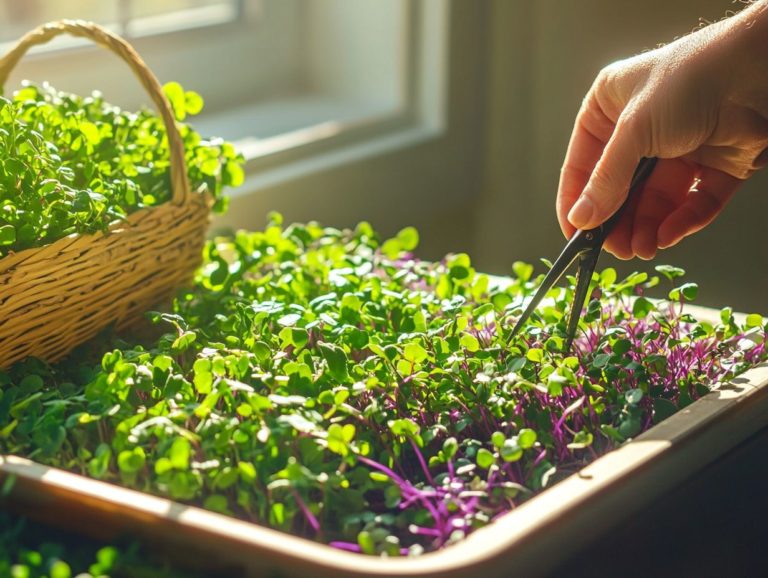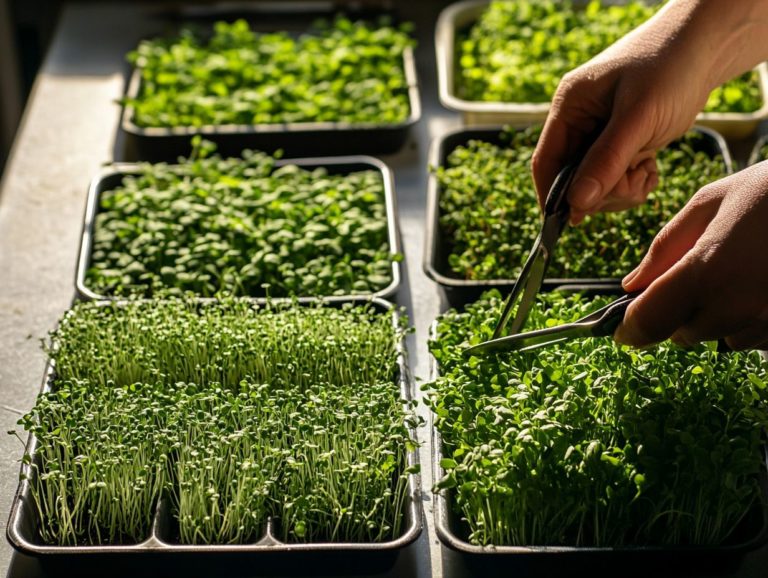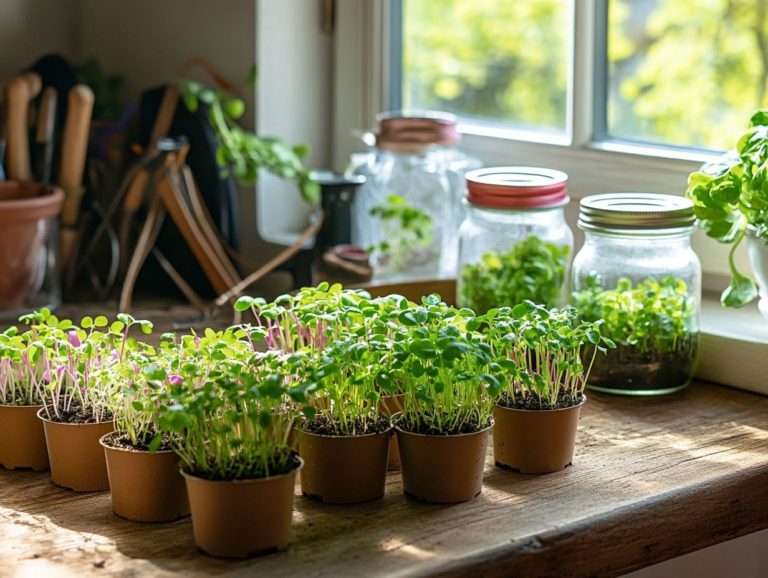5 Tips for Successful Microgreen Preservation
Microgreens are a vibrant addition to any dish, bursting with flavor and nutrients. Get ready to take your culinary game to the next level!
To fully enjoy their remarkable benefits, mastering the art of proper preservation is essential. This article presents invaluable tips for successfully storing microgreens, ensuring they remain fresh and flavorful for an extended period.
You ll discover everything from the ideal harvesting time to the best storage practices. Plus, it delves into common mistakes to avoid, creative uses, and the health benefits of keeping these tiny powerhouses at their best.
Contents
Key Takeaways:
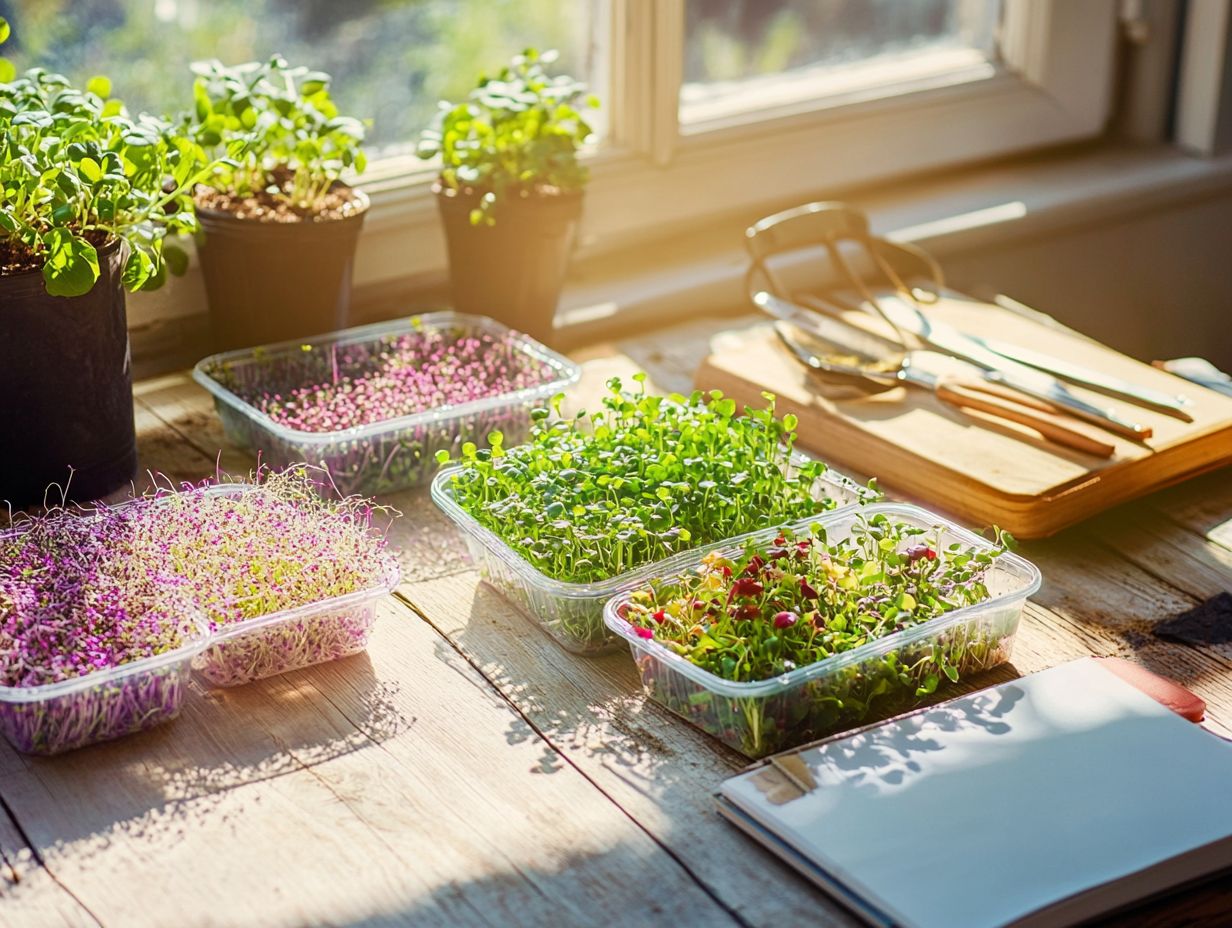
- Harvest microgreens at the right time for the best taste and health benefits.
- Clean and dry microgreens thoroughly before storing to prevent spoilage.
- Use airtight containers to keep microgreens fresh longer.
1. Harvest at the Right Time
Harvesting microgreens at the perfect moment is essential for achieving the best taste, health benefits, and shelf life. These delicate greens are sensitive to their growing conditions, and precise timing is critical to maximizing their nutritional value and flavor.
Take arugula, for example. It develops a delightful peppery flavor when you harvest it just after the first true leaves emerge. Sunflower shoots shine brightest when picked at around 6 inches tall, enhancing their nutty profile. And let s not forget cilantro microgreens; gathering them before they bolt is crucial, as this can significantly impact their taste and health benefits.
You should also consider factors like germination rates, which refer to how quickly seeds sprout, and the environment. Proper light, temperature, and moisture levels can elevate these greens from mere decorative greens to nutrient-packed powerhouses that invigorate your meals and enhance your wellness.
2. Clean and Dry Thoroughly
To maintain the freshness and health benefits of microgreens, it’s vital to clean and dry them thoroughly after harvest. This ensures excess moisture is removed to prevent spoilage.
Start by gently rinsing the microgreens under cool running water to wash away any dirt or contaminants. Once rinsed, place them carefully on a clean towel or in a salad spinner to pat them dry. Removing moisture is key, as damp conditions can lead to the growth of mold or bacteria, ultimately compromising their shelf life. For optimal results, consider following the best practices for watering microgreens.
When microgreens are mishandled, they not only lose their vibrant flavor and nutritional value, but can also become unsafe to consume. By diligently following these steps, you can savor the full spectrum of health benefits these nutrient-rich plants provide.
3. Use the Proper Storage Containers
Utilizing the right storage containers for microgreens is essential for prolonging their shelf life. This ensures those baby salad greens stay fresh and flavorful while minimizing their exposure to air and moisture.
When you choose options like airtight containers, clamshells, or perforated trays, you significantly impact the quality of your greens. Airtight containers act as a protective barrier against external elements, helping maintain humidity levels and preventing wilting.
Clamshells also allow for some airflow, which is advantageous for keeping your microgreens crisp while offering protection against bruising. Perforated trays enhance air circulation, reducing the risk of mold and spoilage.
Each type of container boasts its own unique benefits, and selecting the right one can elevate the flavor and texture of these vibrant, nutritious plants.
4. Store in the Right Environment
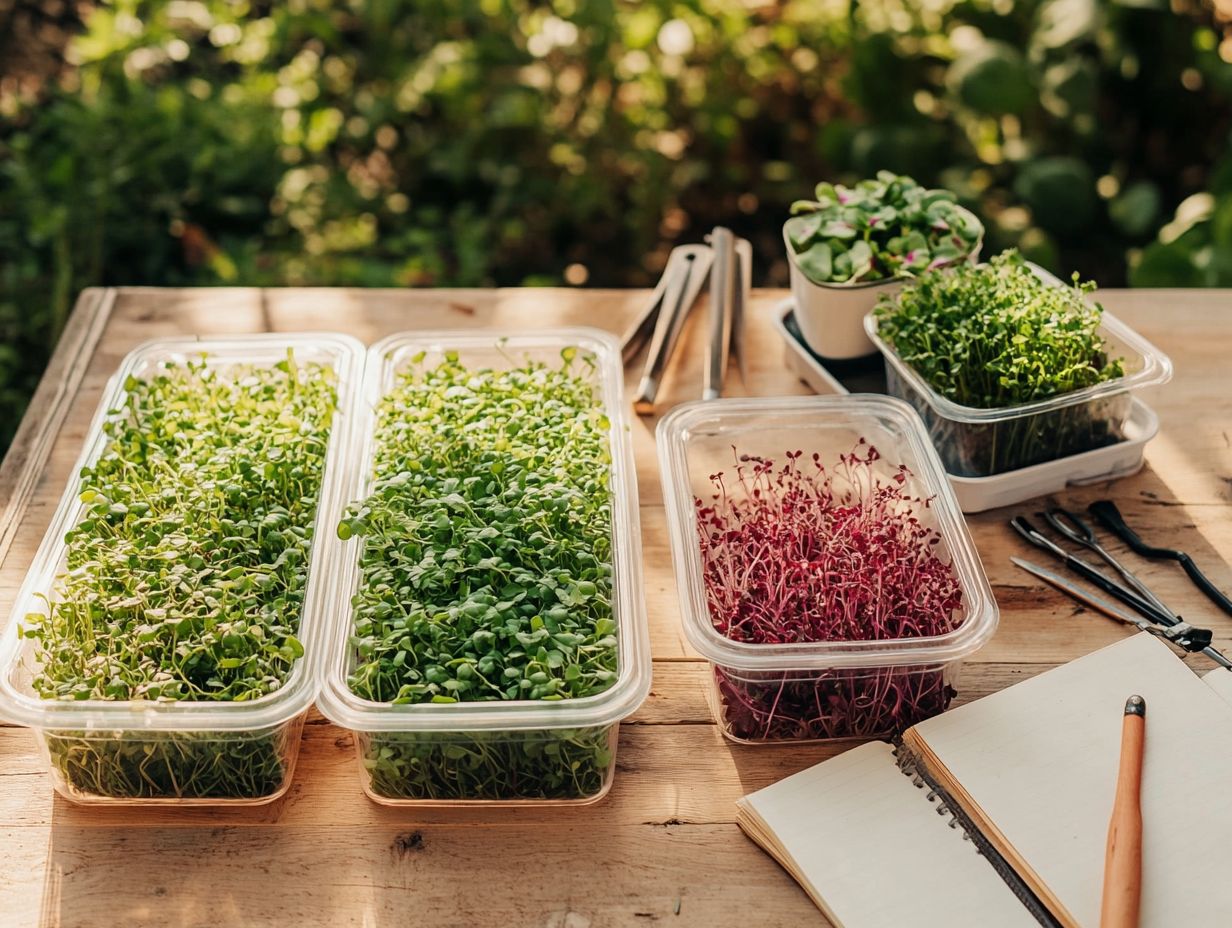
Storing microgreens in the right environment is crucial for preserving their freshness, flavor intensity, and nutritional value. This requires careful management of light, temperature, and humidity levels to prevent degradation.
To achieve optimal storage conditions, keep them in a cool area, ideally between 34 F and 40 F. This range helps slow down metabolic processes that could lead to wilting or spoilage.
It s also essential to minimize exposure to direct sunlight. Opting for a dimly lit space will help maintain their bright colors and delicate textures.
Humidity plays a vital role; maintaining the amount of moisture in the air at around 50-70% can prevent excessive moisture loss, ensuring the microgreens stay crisp. By diligently monitoring these conditions and applying techniques from our guide on how to maximize yields from microgreens, you can enjoy the full array of health benefits and flavors that microgreens offer for an extended period.
5. Rotate and Use Them Regularly
Using a plan to use different microgreens regularly can significantly enhance your culinary creations. This ensures you enjoy the freshness and flavor contrasts these greens bring to a balanced diet.
This method enhances the taste of your meals while unlocking a broader spectrum of vitamins, minerals, and antioxidants. For instance, arugula microgreens infuse a delightful peppery kick, while basil microgreens offer a sweet, aromatic finish to salads and pasta.
Rotating varieties like sunflower for their satisfying crunch and beet greens for their earthy depth enrich both the palate and nutritional profile of your meals. Consider introducing different types into your daily fare whether in smoothies, sandwiches, or as garnishes for soups to fully experience the diverse benefits they provide.
Discover the Buzz About Microgreens!
Microgreens are young, edible plants harvested at their peak freshness. They are celebrated for their intense flavors, bright colors, and remarkable health benefits. This makes them an increasingly sought-after option in urban farming and home gardening, especially for those looking to elevate their salads and dishes with nutrient-packed baby greens.
These little powerhouses, including varieties like arugula, radish, and basil, don t just enhance the visual appeal of your meals; they also deliver concentrated bursts of vitamins, minerals, and antioxidants. As you become more aware of their nutritional perks think high antioxidant content and essential nutrients it’s no wonder the trend of cultivating microgreens at home is skyrocketing.
This rising interest shows that more people want to live sustainably and enjoy fresh produce, giving you the power to grow your own greens even in limited spaces.
By adding these flavorful gems to your daily meals, you can effortlessly transform ordinary dishes into culinary masterpieces. Don t wait! Start incorporating these microgreens into your meals today!
What Are the Best Ways to Harvest Microgreens?
The best ways to harvest microgreens involve specific techniques tailored to each plant type. For delicate varieties like arugula and cilantro, using sharp scissors is essential. This approach minimizes damage to the roots and maximizes quality.
For sturdier varieties such as sunflower and pea shoots, a clean knife offers a more controlled cut at the base. It s vital to have all your tools prepared and sanitized to prevent contamination.
If you’re harvesting larger batches, employing a harvesting tray can help you catch the greens while keeping your workspace organized. By paying close attention to the unique characteristics of each microgreen and utilizing the right tools, you can elevate both the flavors and presentation. Additionally, following some tips for growing microgreens in winter can ensure these vibrant plants stay fresh and visually appealing.
What Are the Common Mistakes in Microgreen Preservation?

Microgreen preservation mistakes can harm both their health benefits and shelf life. Issues like poor moisture control, inadequate cleaning, and unsuitable storage lead to spoilage.
Many errors stem from not understanding microgreens’ specific needs. They thrive in a carefully maintained environment. Neglecting to wash them thoroughly before storage risks introducing harmful bacteria.
Proper drying is crucial. If they re too wet, they can decay quickly. Containers that restrict airflow create a stifling environment, hastening spoilage.
To keep microgreens fresh, follow effective cleaning steps. Ensure they are completely dried and use storage solutions that promote longevity.
How Can One Extend the Shelf Life of Microgreens?
Extending the shelf life of microgreens means creating optimal storage conditions. Control humidity and temperature to maintain their freshness and flavor.
Focus on minimizing spoilage risks. Moisture management is vital; excess moisture can lead to mold growth. Use moisture-absorbing materials to help regulate the environment effectively.
Consistent temperature is key to preventing degradation. Aim for 34 F to 39 F. Smart storage techniques, like breathable containers that allow airflow, keep microgreens crunchy.
Manage watering practices by adjusting the schedule before harvest. This ensures they stay vibrant and nutritious longer. To avoid issues, be aware of the top 5 mistakes in growing microgreens. Proper light management and optimal germination rates also enhance their overall health.
What Are Some Creative Ways to Use Preserved Microgreens?
Preserved microgreens can be your secret weapon in the kitchen! They add delightful flavor and a wealth of health benefits to your dishes, whether you’re crafting a salad or perfecting garnishes like cilantro microgreens.
These tiny powerhouses, including arugula and sunflower shoots, can elevate a simple omelet with their zesty crunch or transform a creamy soup with a vibrant touch of freshness.
Picture this: a sprinkle of preserved microgreens on your pizza just before serving, or blending them into sauces for an extra layer of depth. Don’t miss out on the benefits!
Incorporating these microgreens into smoothies offers a quick and easy way to boost nutrition without sacrificing flavor, making them ideal for those hectic mornings. Their versatility invites you to experiment with new flavor profiles, ensuring your meals are brimming with essential vitamins and minerals.
Are There Any Nutritional Benefits to Preserving Microgreens?
You ll love enjoying the fresh taste of preserved microgreens for longer! Preserving them allows you to keep their impressive nutritional benefits, which can rival those of fully grown vegetables. This ensures their rich flavors and health advantages are always at your fingertips, even after storage. Using hydroponic media, a method for growing plants without soil, can also enhance their shelf life.
These vibrant greens, like broccoli and red clover, are a great source of nutrients, filled with vitamins, minerals, and antioxidants. They can elevate any meal! By using proper preservation techniques such as refrigeration, drying, or freezing, you can extend their shelf life without losing essential nutrients. Additionally, learn how to extend the growing season for microgreens to enjoy them even longer.
For instance, vacuum sealing helps maintain their crisp texture and potent flavors. It also reduces oxidation, which can impact their quality. By ensuring a proper seeding rate during planting, you can promote optimal growth. When you take the time to care for them properly, microgreens can continue to enhance your diet long after harvesting. For more insight, check out these essential tips for growing microgreens at home.
Frequently Asked Questions

What are microgreens?
Microgreens, such as amaranth and buckwheat, are young, edible plants that are harvested at an early growth stage. They are known for their high nutritional value and can be easily grown at home in an indoor grower setup.
Why is it important to preserve microgreens?
Preserving microgreens allows you to enjoy their freshness and nutritional benefits for a longer period, especially when you use methods like urban farming. It also helps reduce food waste and can save you money over time.
What are the 5 tips for successful microgreen preservation?
- 1. Harvest at the right time: Microgreens should be harvested when they have developed their first set of true leaves, ensuring the ideal harvest time, and before they start to wilt.
- 2. Store in the fridge: Place harvested microgreens in an airtight container or plastic bag and store them in the fridge. This helps retain their freshness and nutrients, especially when employing a blackout dome during storage.
- 3. Rinse and dry before storing: Before storing, rinse your microgreens, like sunflower shoots, in cold water and dry them thoroughly. Excess moisture can cause spoilage.
- 4. Use within a week: Microgreens, including varieties like cilantro and Vates Collard Greens, are best consumed within a week of harvesting. After that, their nutritional value may decline, and they may start to wilt.
- 5. Freeze for long-term preservation: If you want to keep microgreens for an extended period, including sprouts and other tender varieties, freeze them. Spread them on a baking sheet and freeze for a few hours before transferring to an airtight container.
Can I preserve all types of microgreens using these tips?
Yes! These preservation tips can be applied to all types of microgreens, including arugula, sunflower shoots, broccoli, and pea shoots, as well as baby salad greens.
Can I use preserved microgreens in cooking?
Absolutely! Preserved microgreens can be used in cooking just like fresh ones. They can be added to salads, sandwiches, soups, and other dishes for an extra boost of flavor intensity and nutrition.

